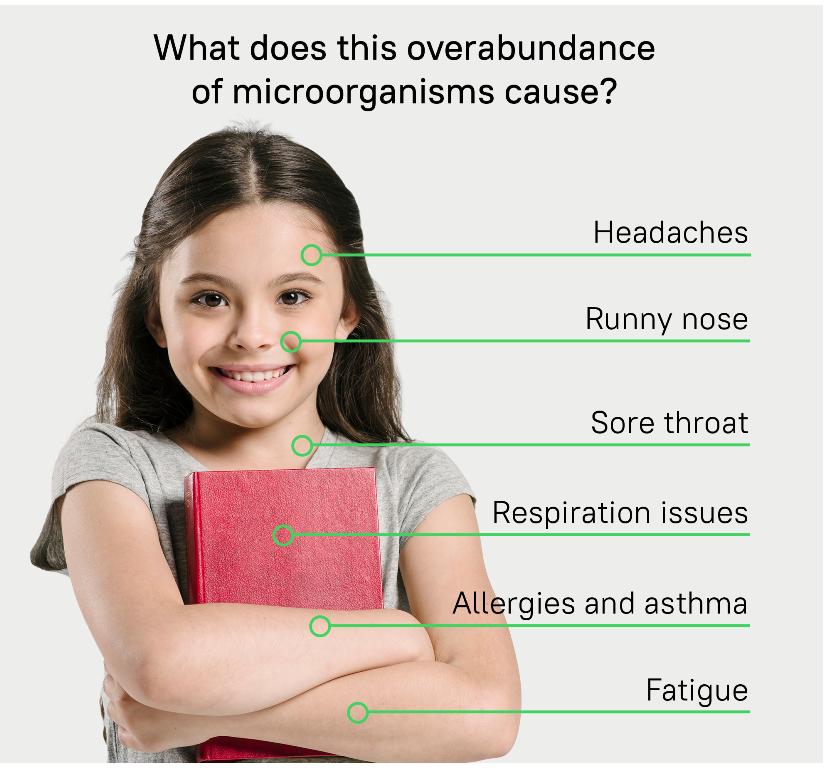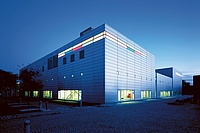
AAF’s Air Purifiers improve IAQ in Bratislavian Schools
End User: School and Kindergardens Bratislava a.s. Slovakia
Industry: Commercial Buildings
Each day you breathe air into your lungs more than 20.000 times. Children spend about 16 years of their lives in either school or pre-school, which equates to or over 140.000 hours indoors. The air inside a school building contains hundreds of different species of bacteria, fungi and moulds.
Respiratory symptoms such as rhinitis, coughing, and breathing difficulties, as well as allergies and asthma, have been clinically associated with these microbial contaminants.
Indoor air quality problems are considered to be significant risk factors for human health. Even the World Health Organization (WHO) has developed guidelines for protection against health risks caused by moisture, microbial growth
and indoor contamination.
Our objective has been to determine the level of microbial contamination in school and preschool facilities.

Indoor environmental quality analysis and microbial contamination of the and surface.
The sampling methods selected by us involved suctioning air into a monitoring device and swabbing surfaces. An analysis of samples taken from active aspiration of air inside schools and kindergartens, specifically from classrooms, dressing rooms, dining halls and gymnasia, recorded growth in all monitored groups, particularly bacteria and moulds.
Bacteria were captured at levels exceeding limits with the identified genera and species falling into two groups.
The first consists of bacteria commonly found in soil, for example, which either the building’s air ventilation system drew indoors or clothing and footwear took inside. The second group is composed of the bacteria that are a natural element of the microbiota found on human skin and mucous membranes. It was brought indoors by the very people who spend time there. Some bacteria species can occasionally become pathogens in the right conditions, such as when immunity is weakened.
No primary pathogenic species (capable of causing infections even in healthy humans) were detected in the samples.
Compared to bacteria, moulds were detected at lower levels and yet above acceptable limits. They produce large numbers of tiny spores that are capable of penetrating deep into the respiratory tract. Under the right environmental conditions, the spores can germinate, grow, and multiply rapidly. They have a high allergenic potential when they proliferate.

Healthy Schools and Kindergartens involves the placement of high-performance air purifiers in rooms earlier analysed. These purifiers were tasked with completely filtering the air and preventing the occurrence of microbiological indicators. During a two-month trial period, the purifiers were placed in classrooms, a dining hall and gymnasium, each time while children were present.
Two months later, a swab was taken directly from the first filter, which had been capturing dust particles from the room and concurrently filtering out airborne microorganisms. Having clearly demonstrated the purifier’s effectiveness, the bacteria, moulds and yeasts trapped by the filter were exactly quantified and the now cleaner room was permanently decontaminated.

End User: School and Kindergardens Bratislava a.s. Slovakia
Industry: Commercial Buildings
Each day you breathe air into your lungs more than 20.000 times. Children spend about 16 years of their lives in either school or pre-school, which equates to or over 140.000 hours indoors. The air inside a school building contains hundreds of different species of bacteria, fungi and moulds.
Respiratory symptoms such as rhinitis, coughing, and breathing difficulties, as well as allergies and asthma, have been clinically associated with these microbial contaminants.
Indoor air quality problems are considered to be significant risk factors for human health. Even the World Health Organization (WHO) has developed guidelines for protection against health risks caused by moisture, microbial growth
and indoor contamination.
Our objective has been to determine the level of microbial contamination in school and preschool facilities.

Indoor environmental quality analysis and microbial contamination of the and surface.
The sampling methods selected by us involved suctioning air into a monitoring device and swabbing surfaces. An analysis of samples taken from active aspiration of air inside schools and kindergartens, specifically from classrooms, dressing rooms, dining halls and gymnasia, recorded growth in all monitored groups, particularly bacteria and moulds.
Bacteria were captured at levels exceeding limits with the identified genera and species falling into two groups.
The first consists of bacteria commonly found in soil, for example, which either the building’s air ventilation system drew indoors or clothing and footwear took inside. The second group is composed of the bacteria that are a natural element of the microbiota found on human skin and mucous membranes. It was brought indoors by the very people who spend time there. Some bacteria species can occasionally become pathogens in the right conditions, such as when immunity is weakened.
No primary pathogenic species (capable of causing infections even in healthy humans) were detected in the samples.
Compared to bacteria, moulds were detected at lower levels and yet above acceptable limits. They produce large numbers of tiny spores that are capable of penetrating deep into the respiratory tract. Under the right environmental conditions, the spores can germinate, grow, and multiply rapidly. They have a high allergenic potential when they proliferate.

Healthy Schools and Kindergartens involves the placement of high-performance air purifiers in rooms earlier analysed. These purifiers were tasked with completely filtering the air and preventing the occurrence of microbiological indicators. During a two-month trial period, the purifiers were placed in classrooms, a dining hall and gymnasium, each time while children were present.
Two months later, a swab was taken directly from the first filter, which had been capturing dust particles from the room and concurrently filtering out airborne microorganisms. Having clearly demonstrated the purifier’s effectiveness, the bacteria, moulds and yeasts trapped by the filter were exactly quantified and the now cleaner room was permanently decontaminated.


 FHK Polska
FHK Polska PureMedion Kft.
PureMedion Kft. Elfa spol. s r. o.
Elfa spol. s r. o. Ecotip d.o.o.
Ecotip d.o.o.

